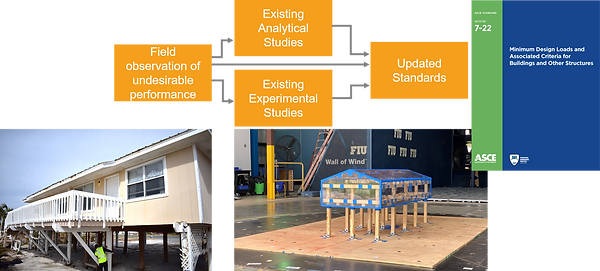
NICHE
Convergence Research at NICHE
Why a Convergence Approach?
Even with the distributed assets of NHERI available to the research community, convergence is still quite rare in practice, and often the result of fortuitous chain of events. Consider the experience of Professor Elaina Sutley (University of Kansas).
Even with the distributed assets of NHERI available to the research community, convergence is still quite rare in practice, and often the result of fortuitous chain of events. Consider the experience of Professor Elaina Sutley (University of Kansas).
Elevated homes are common in coastal areas, but pressure descriptions in contemporary standards did not initially consider the effects of elevation. Prof. Sutley worked on StEER's Virtual Assessment Structural Team for 2018's Hurricane Michael and went on to secure a RAPID Grant from NSF that allowed her to document damage to elevated homes in this major hurricane. She observed damage to the undersides of these elevated homes and leveraged existing and ongoing experimental and analytical research, including studies at the Wall of Wind at Florida International University.

Now with data confirming the higher suction pressures on floor system and its cladding elements, she worked with colleagues to propose changes to ASCE 7-22 that formally define procedures for calculating pressures on the underside of these elevated buildings. A lot of pieces fell in to place to speed this process of moving learnings from a 2018 event to changes in practice by 2022. NICHE's Convergence Research Infrastructure wants to take the luck out of it!
Convergence...NICHE-Style
We wanted NICHE to be more than a novel physical testing facility, but a novel research infrastructure that promotes not just one but three types of convergence that will wrap around NICHE's world-class experimental capabilities.
-
Disciplinary Convergence: understanding that discovery operates at the intersection of multiple engineering disciplines with the behavioral, social, and economic sciences
-
Methodological Convergence: optimally leveraging the strengths of computational simulations, physical testing, and field observations
-
Institutional Convergence: contextualizing research within disaster-affected communities to accelerate impacts on policy and practice.
Thus, while the technical team is working on the design requirements for the experimental capabilities, a separate team is designing the programming and enabling infrastructure that will animate these three forms of convergence at NICHE.
Benefits of Methodological Convergence
The team is actively using methodological convergence in the NICHE design -- capabilities that will be particularly powerful for our users. Most NHERI facilities focus on a single methodology – computational simulation or field observations or physical experiments – in NICHE we want to link these all together for our users. So our team is creating interfaces that facilitate a two-way flow of data between each of these methodological components and at their interfaces. This gives users greater flexibility to choose the combination of methods most appropriate for the research question at hand.
-
Field observations can be used to inform the computational simulations we conduct, and when possible, provide data that can be used for validation.
-
By connecting experimental testing with field observations we can recreate curated storm scenarios to understand how failures evolve.
-
In turn, as we run simulations or experiments, we often find gaps in knowledge where further field observations would be valuable.
-
Computational simulation enables Digital Twins to not only to design experiments, but in turn, to develop models verified and validated with experimental results, allowing users to extend their investigations ell beyond the limited number of experiments they can conduct.
-
In instances where the scale or complexity of specimen exceeds even NICHE's capabilities or available resources, then hybrid simulation can provide a critical bridge between experiments and high-fidelity computational models.

The NICHE User Experience
Thanks to NICHE's emphasis on Convergence Research, the facility is being designed to integrate the best of the capabilities currently spread across all the NHERI network in a single facility. With a Workforce Development Program that trains users on how to take advantage of these capabilities, Convergence Research Infrastructure that connects field observations, computational models and experimental data, and Stakeholder Engagement Program that ensures stakeholder input is considered from the outset of every project, NICHE is poised to deliver a distinctive user experience.

1. A researcher reads NICHE's Science Plan revealing gaps informed by field observations in past storms and practitioner insights.
2. They contact NICHE's staff to explore an early-stage proposal concept and co-design the project with NICHE stakeholder groups.
3. The researcher uses NICHE's Digital Twin to conceptualize the test plan and finalize a successful proposal.
4. This proposal selected a scenarios to test using smaller-scale models in a NICHE partner facility.
9. NICHE's research translation services facilitate connections to appropriate standards committees, assigns mentors skilled in codification process, and provides tips for successful proposals to standards bodies so the proposed revision is quickly approved.
8. And even conduct benefit-cost analyses for proposed mitigation measures
7. This model can be embedded in one of NICHE's testbed community models to quantify socio-economic impacts under various storm scenarios
5. Based on Digital Twin and scaled model results, the researcher conducts a more focused suite of full-scale tests at NICHE, selecting on of NICHE's curated storms to recreate a legacy hurricane from the Science Plan.
6. Experimental results are used to refine and validate a computational model of the structure from NICHE's curated model library – allowing the researcher to explore a wider range of building configurations and hazard intensities